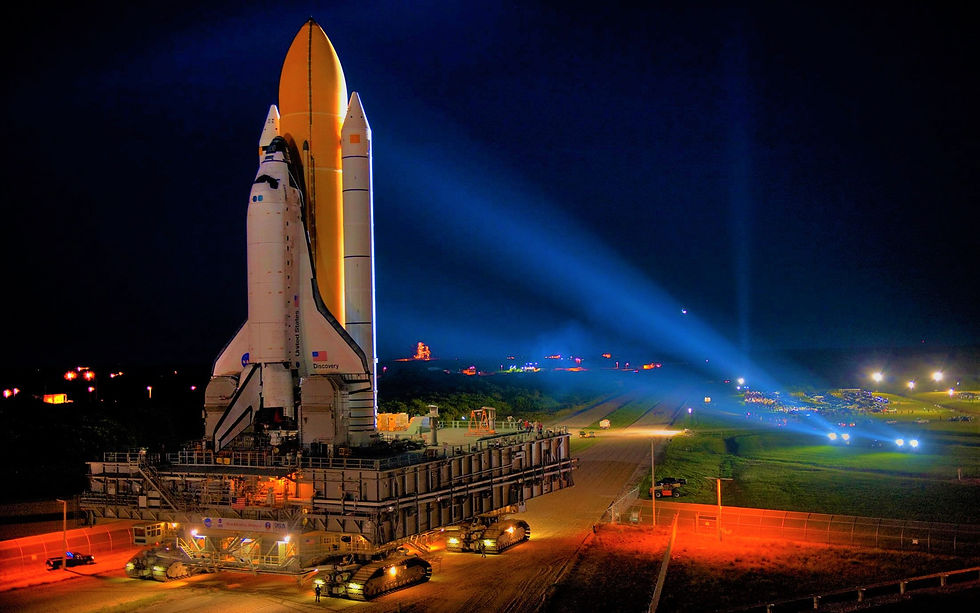Voyager
- pilot55kassas55
- 19 يوليو 2022
- 3 دقيقة قراءة
The Voyager program is an American scientific program that employs two robotic interstellar probes, Voyager 1 and Voyager 2. They were launched in 1977 to take advantage of a favorable alignment of Jupiter and Saturn, to fly near them while collecting data for transmission back to Earth. After launch the decision was taken to send Voyager 2 near Uranus and Neptune to collect data for transmission back to Earth.
As of 2022, Voyager 1 was moving with a velocity of 61,185 kilometers per hour (38,019 mph), or 17 km/s, relative to the Sun, and was 23,252,000,000 kilometers (1.4448×1010 mi) from the Sun reaching a distance of 155.8 AU (23.3 billion km; 14.5 billion mi) from Earth as of February 10, 2022. On 25 August 2012, data from Voyager 1 indicated that it had entered interstellar space.
As of 2022, Voyager 2 was moving with a velocity of 55,335 kilometers per hour (34,384 mph), or 15 km/s, relative to the Sun, and was 19,350,000,000 kilometers (1.202×1010 mi) from the Sun reaching a distance of 130.1 AU (19.5 billion km; 12.1 billion mi) from Earth as of February 10, 2022. On 5 November 2019, data from Voyager 2 indicated that it also had entered interstellar space. On 4 November 2019, scientists reported that, on 5 November 2018, the Voyager 2 probe had officially reached the interstellar medium (ISM), a region of outer space beyond the influence of the solar wind, as did Voyager 1 in 2012.
Voyager1
Voyager 1 is a space probe launched by NASA on September 5, 1977, as part of the Voyager program to study the outer Solar System and interstellar space beyond the Sun's heliosphere. Launched 16 days after its twin Voyager 2, Voyager 1 has been operating for 44 years, 10 months and 13 days as of July 19, 2022 UTC and still communicates with the Deep Space Network to receive routine commands and to transmit data to Earth. Real-time distance and velocity data is provided by NASA and JPL. At a distance of 156.29 AU (23.381 billion km; 14.528 billion mi) from Earth as of July 14, 2022, it is the most distant artificial object from Earth.
The probe made flybys of Jupiter, Saturn, and Saturn's largest moon, Titan. NASA had a choice of either doing a Pluto or Titan flyby; exploration of the moon took priority because it was known to have a substantial atmosphere. Voyager 1 studied the weather, magnetic fields, and rings of the two gas giants and was the first probe to provide detailed images of their moons.
Voyager2
Voyager 2 is a space probe launched by NASA on August 20, 1977, to study the outer planets and interstellar space beyond the Sun's heliosphere. A part of the Voyager program, it was launched 16 days before its twin, Voyager 1, on a trajectory that took longer to reach gas giantsJupiter and Saturn but enabled further encounters with ice giantsUranus and Neptune.Voyager 2 remains the only spacecraft to have visited either of the ice giant planets. Voyager 2 was the fourth of five spacecraft to achieve Solar escape velocity, which allowed it to leave the Solar System.
Voyager 2 successfully fulfilled its primary mission of visiting the Jovian system in 1979, the Saturnian system in 1981, Uranian system in 1986, and the Neptunian system in 1989. The spacecraft is now in its extended mission of studying interstellar space. It has been operating for 44 years, 10 months and 28 days as of July 18, 2022 UTC as of February 9, 2022, it has reached a distance of 129.9 AU (19.433 billionkm; 12.075 billion mi) from Earth.
The probe entered interstellar space on November 5, 2018, at a distance of 122 AU (11.3 billion mi; 18.3 billion km) (about 16:58 light-hours) from the Sun and moving at a velocity of 15.341 km/s (34,320 mph) relative to the star. Voyager 2 has left the Sun's heliosphere and is traveling through the interstellar medium (ISM), a region of outer space beyond the influence of the Solar System, joining Voyager 1, which had reached the interstellar medium in 2012. Voyager 2 has begun to provide the first direct measurements of the density and temperature of the interstellar plasma.





تعليقات